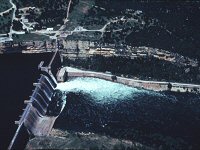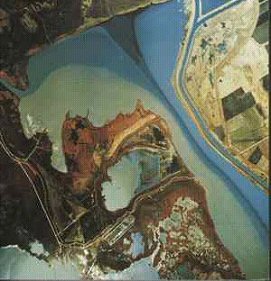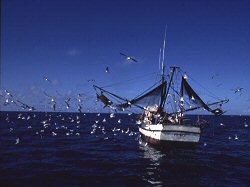Freshwater Inflow Needs Studies – The Texas Bays and Estuaries Program
Freshwater inflows define estuaries. Scientists, anglers and the Texas Legislature all agree that adequate inflows – the right amount of freshwater at the right time – are important for maintaining the health and productivity of estuaries. In recognition of this fact, the Texas Legislature as early as 1985 passed laws directing the Texas Parks and Wildlife Department and the Texas Water Development Board to jointly maintain a data collection and analytical study program focused on determining the needs for freshwater inflows to the state’s bays and estuaries. The agencies were also directed to identify the salinity, nutrient, and sediment loading regimes in the receiving bay and estuary system that are adequate to maintain an ecologically sound environment. The goal was to provide information about what is necessary to maintain the productivity of fish and shellfish species and estuarine life that supports those species.

To accomplish this work TPWD and TWDB developed a methodology for determining beneficial freshwater inflows for Texas’ estuaries. To date, freshwater inflow studies have been completed for the seven major estuaries in Texas. Currently two of the seven studies are being updated. There are seven major components to this methodology:
- Hydrographic Surveys – collection of physical data such as water current velocity and direction for modeling estuary and bay water circulation;
- Circulation or Hydrodynamic and Salinity Modeling - simulation models of circulation and salinity patterns under different inflow conditions;
- Sediment Analyses – identification of sediment needs provided by rivers to maintain delta and wetland areas;
- Nutrient Analyses – computation of nutrient needs such as nitrogen and phosphorous for maintaining positive nutrient balance;
- Fisheries Analyses – quantification of fisheries abundance related to inflows for maintaining production and harvest;
- Freshwater Inflow Optimization Modeling – determination of seasonal freshwater inflow targets, which are tied to the historic monthly flows, and must satisfy all the salinity, nutrient, sediment and productivity requirements.
- Verification of Needs – evaluation of inflow solutions to verify that inflow levels produced by models will maintain ecological health and productivity.
Freshwater Inflow Needs Implementation

In Texas when water in lakes, rivers and streams is used for beneficial purposes, permits must be obtained from the Texas Commission on Environmental Quality (TCEQ). Since 1985, when TCEQ evaluates a request for surface water, they must also consider the effect that issuance of a permit to take, store or divert surface water will have on freshwater inflows and instream flows. TCEQ is also required to include permit conditions necessary to maintain beneficial inflows - “to the extent practicable when considering all public interests”. Because some permit requests have considerable water use conflicts the permitting process can be very long.
Several major reservoirs are operated to provide freshwater inflows for bays and estuaries. Lake Texana near Edna was permitted before the above described freshwater inflow determinations were complete. As a result, the permit conditions were based on the best science available at the time. More recently, consideration was given to incorporating the freshwater inflow needs study results that are now available but all parties agreed that the final outcome would not change significantly so no change was made. Choke Canyon Reservoir near Corpus Christi is also operated in a manner that allows freshwater inflows to pass through to the Nueces Estuary (Corpus Christi Bay). An Estuary Advisory Council was also created for the Nueces Estuary to oversee future modifications to the reservoir’s operating plan.

The Highland Lakes System (which includes Lake Travis and Lake Buchanan) is operated by the Lower Colorado River Authority. With stakeholder input, the LCRA has developed a Water Management Plan that provides instream flows and freshwater inflows to Matagorda Bay. Their Water Management Plan undergoes revision every five years to ensure that the best available information is used in managing the water resources of the Lower Colorado Basin.
Choke Canyon Reservoir, Lake Texana and the Highland Lakes are all operated in a similar manner. When hydrologic conditions (as represented by reservoir storage) are adequate, higher inflows are allowed to pass downstream through the reservoir without being stored. When reservoir storage drops below a threshold or trigger level due to drought, pass-throughs to the estuary are reduced, sometimes drastically. In the case of Choke Canyon Reservoir, when reservoir storage is at the lowest levels, there are provisions for completely suspending reservoir pass-throughs. This operating philosophy is also the basis for the Environmental Planning Criteria, used by the regional planners for estimating environmental flow needs when planning for future water needs. This philosophy helps ensure that during times of drought there is an equitable means for “sharing the pain” of water shortage.

Several estuaries in Texas do not have provisions in place for providing freshwater inflows. However, legislation passed in 2003 created the Study Commission on Water for Environmental Flows to explore the issue of how best to provide water for bays and estuaries and rivers and streams. The Study Commission, in its interim report to the Legislature, proposed a strategy to address the protection of environmental flows for individual bay systems.
© Copyright Texas Parks and Wildlife Department. No part of this work may be copied, reproduced, or translated in any form or medium without the prior written consent of Texas Parks Wildlife Department except where specifically noted. If you want to use these articles, see Site Policies